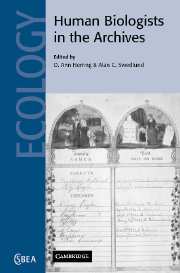 Human Biologists in the Archives
Human Biologists in the Archives Book contents
- Frontmatter
- Contents
- Contributors
- Foreword by Sydel Silverman and Michael A. Little
- Acknowledgements
- 1 Human biologists in the archives: demography, health, nutrition and genetics in historical populations
- 2 The use of archives in the study of microevolution: changing demography and epidemiology in Escazú, Costa Rica
- 3 Anthropometric data and population history
- 4 For everything there is a season: Chumash Indian births, marriages, and deaths at the Alta California missions
- 5 Children of the poor: infant mortality in the Erie County Almshouse during the mid nineteenth century
- 6 Worked to the bone: the biomechanical consequences of ‘labor therapy’ at a nineteenth century asylum
- 7 Monitored growth: anthropometrics and health history records at a private New England middle school, 1935–1960
- 8 Scarlet fever epidemics of the nineteenth century: a case of evolved pathogenic virulence?
- 9 The ecology of a health crisis: Gibraltar and the 1865 cholera epidemic
- 10 War and population composition in Åland, Finland
- 11 Infectious diseases in the historical archives: a modeling approach
- 12 Where were the women?
- 13 Malnutrition among northern peoples of Canada in the 1940s: an ecological and economic disaster
- 14 Archival research in physical anthropology
- Index
- References
2 - The use of archives in the study of microevolution: changing demography and epidemiology in Escazú, Costa Rica
Published online by Cambridge University Press: 12 August 2009
- Frontmatter
- Contents
- Contributors
- Foreword by Sydel Silverman and Michael A. Little
- Acknowledgements
- 1 Human biologists in the archives: demography, health, nutrition and genetics in historical populations
- 2 The use of archives in the study of microevolution: changing demography and epidemiology in Escazú, Costa Rica
- 3 Anthropometric data and population history
- 4 For everything there is a season: Chumash Indian births, marriages, and deaths at the Alta California missions
- 5 Children of the poor: infant mortality in the Erie County Almshouse during the mid nineteenth century
- 6 Worked to the bone: the biomechanical consequences of ‘labor therapy’ at a nineteenth century asylum
- 7 Monitored growth: anthropometrics and health history records at a private New England middle school, 1935–1960
- 8 Scarlet fever epidemics of the nineteenth century: a case of evolved pathogenic virulence?
- 9 The ecology of a health crisis: Gibraltar and the 1865 cholera epidemic
- 10 War and population composition in Åland, Finland
- 11 Infectious diseases in the historical archives: a modeling approach
- 12 Where were the women?
- 13 Malnutrition among northern peoples of Canada in the 1940s: an ecological and economic disaster
- 14 Archival research in physical anthropology
- Index
- References
Summary
Introduction
Archival data constitute a rich source of information for microevolutionary studies, a primary focus of human biology and biological anthropology research. Particularly important is that, by virtue of their ubiquity, archives allow researchers to study changes in demography and epidemiology in multiple cultures and time settings. Thus, it is possible to compare microevolutionary processes across cultures at different time periods, and across time within a group. For example, Scott and Duncan (2001) look at the behavior of different epidemics throughout Europe, and at different time periods. Scott and Duncan also (1998) provide a cross-cultural review of the impact of disease on human demography.
Several archival approaches to microevolutionary studies are possible, all of them of interest, and all of them depending on the data available. However, in the best of situations, it could be possible to study mortality and fertility through death and birth/baptism archives, and population structure and gene flow through marriage records. This chapter presents a case study of changes in demography and epidemiology in the historical population of Escazú, Costa Rica, through archival research, which incorporates the mortality, birth, and marriage patterns of the population.
The specific question addressed about mortality is whether it had a seasonal distribution, as has been described in similar human populations.
- Type
- Chapter
- Information
- Human Biologists in the ArchivesDemography, Health, Nutrition and Genetics in Historical Populations, pp. 11 - 31Publisher: Cambridge University PressPrint publication year: 2002


